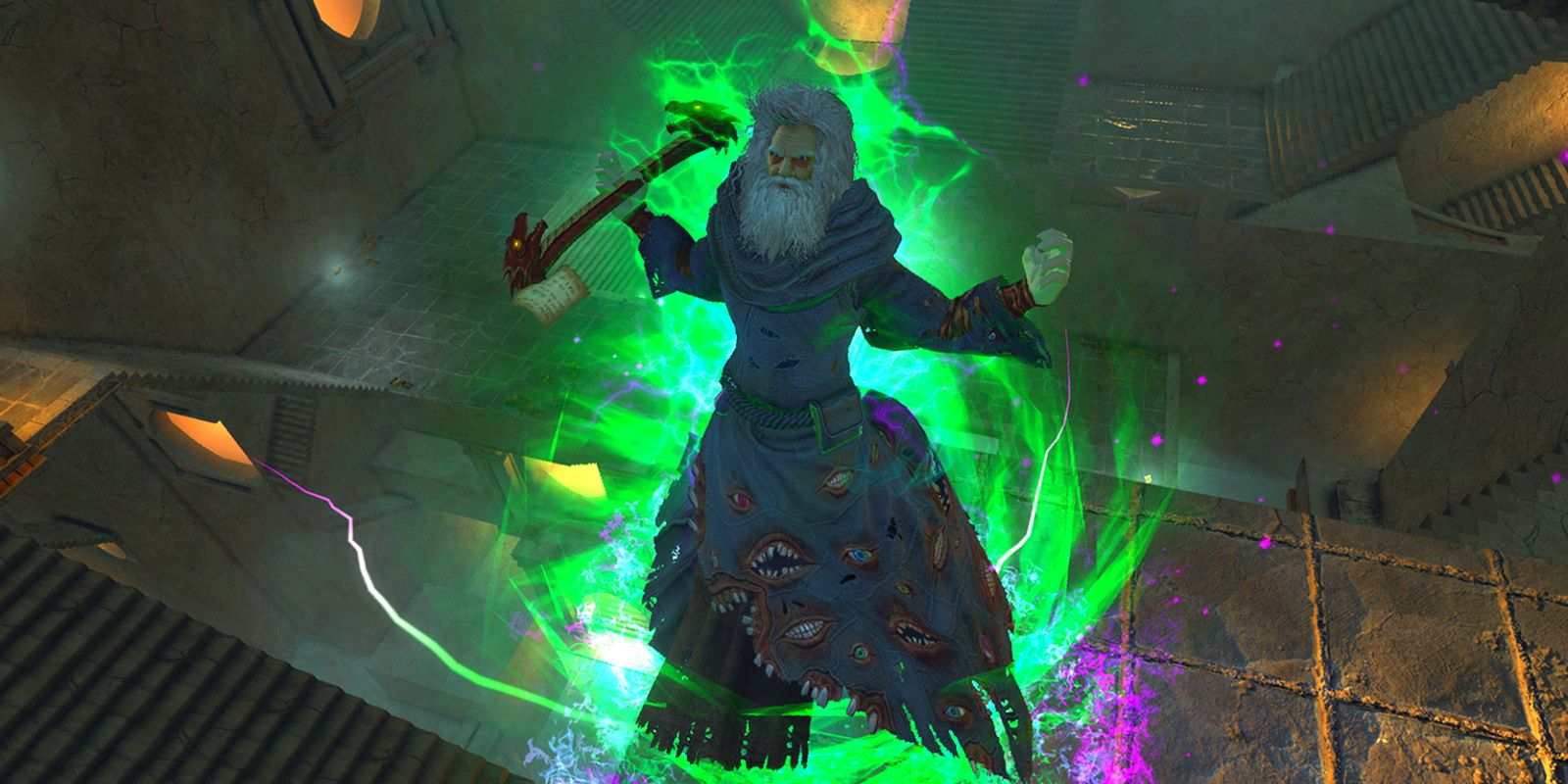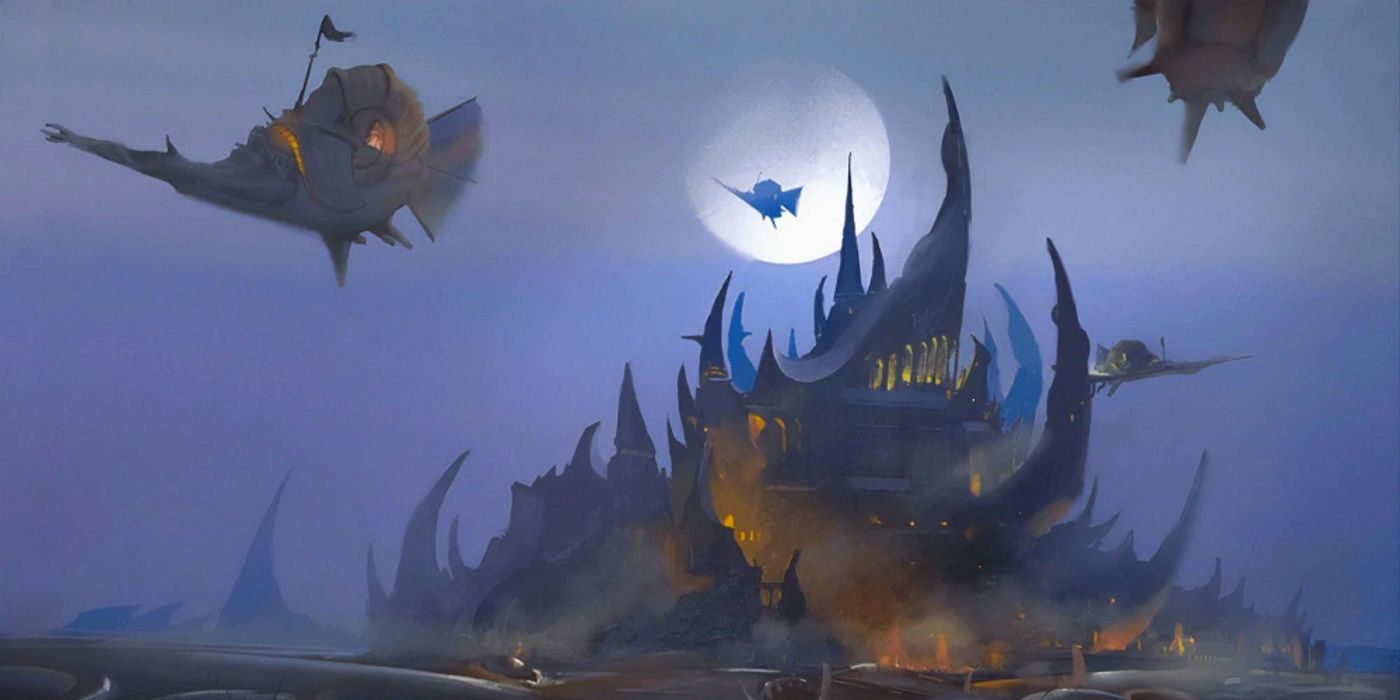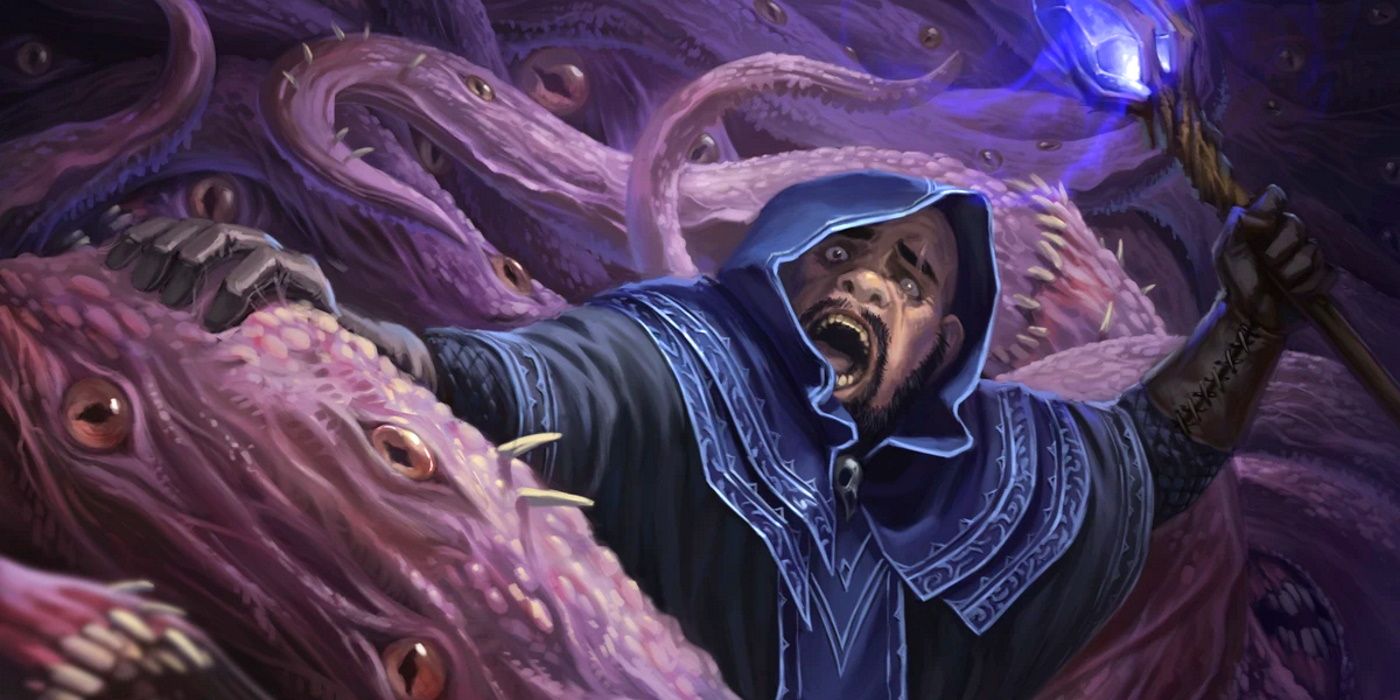Dungeons & Dragons features some foes that can literally drive characters mad. From Demon Lords to creatures from the Far Realm, some beings in D&D are just too powerful for mortal minds to comprehend. That is where madness comes in, and when used correctly, it can be an excellent way for DMs to really enhance a campaign.
While not all campaigns are suitable for using madness in, there are a few ways DMs can introduce this mechanic. D&D has a lot of terrifying monsters and situations for a player's character to face, all of which can both move the plot forward and provide great roleplaying moments. Some of these will create long-lasting effects for the characters to deal with beyond the initial encounter.
Knowing when and how to use madness in a campaign is the key. When used properly, madness is excellent for emphasizing the horror or unnerving dread of a situation. Using it too soon or too frequently can lessen the narrative impact and reduce it to merely being silly for a set number of minutes.
When To Use Madness In D&D
Madness and some words associated with it can be tricky to navigate, as mental health is a real-world issue that many people experience. It is essential for DMs to check in with players from time to time while implementing madness, as it can be a sensitive topic. Using safety tools in D&D is important and something every DM should do when dealing with darker or more mature content.
The question of when to use madness in a D&D campaign can be challenging as, at first glance, the mechanic does seem to have limited applications. The two most obvious examples are a horror-themed campaign where DMs can use madness to emphasize the terror and carnage the players will be encountering, or a campaign that brings players into contact with creatures or beings from other planes, such as the Demon Lords of the Abyss or an aberration from the Far Realm.
However, a campaign does not need to be horror- or extraplanar-themed to use madness. DMs can also use madness in other campaigns to emphasize when something has shaken a character to their core. This could be used alongside other D&D narrative mechanics, such as alignment changes, to underscore these events' impact on a character.
One way to do this would be to build up stress points. Adventurers see a lot of horrible things during the course of a campaign, but none of them drive them mad. DMs could introduce stress points that would trigger a Wisdom saving throw after reaching a set threshold. A failed save would result in a roll on the corresponding madness table.
Madness can be used at low level but is far better suited for high-level characters. As players gain levels and strength, DMs can sometimes struggle to challenge them while still maintaining balance within an encounter. So having really terrifying monsters or enemies do something so horrifying or horrendous that it snaps something in the character's mind is a fun trick to pull out every now and again.
Other great places to use madness are curses on unsuspecting D&D party members, cursed items, or traveling through a strange portal. A player might find the spell book of a terrible hag and take a peek, prompting a Wisdom save due to the vile scribblings within. Traveling through a vast underground labyrinth might take its toll on even the most experienced adventurers, as the constant darkness provokes madness.
Madness is a powerful narrative tool when used at the right time. It can create some brilliant roleplay opportunities for players as characters should remain deeply affected by the experiences madness creates. The best way to use madness as a DM is to make sure that there are consequences that linger.
The Mechanics Behind D&D's Madness
5e D&D's madness, cut from Monsters of the Multiverse, is divided into three types based on the duration of the madness effect. There is short, long, and indefinite madness, each with its own corresponding table in chapter eight of the Dungeon Master's Guide. Each type of madness has different ways to suppress or cure it.
Short-term madness is the first stage of madness for many characters and lasts for 1d10 minutes. This is usually caused by more minor things that might catch the player off guard. Although short-term madness can only last for a maximum of ten minutes, the effects are pretty strong and especially debilitating if occurring in combat. If this occurs, it might be a good idea for DMs to have additional saving throws at the end of the affected player's turn, as it could be argued that the excitement of battle during a D&D encounter has focused them or the pain of taking damage has snapped them out of it.
|
d100 |
Effect (Lasting 1d10 minutes) |
|---|---|
|
01-20 |
The character retreats into his or her mind and becomes paralyzed. The effect ends if the character takes any damage. |
|
21-30 |
The character becomes incapacitated and spends the duration screaming, laughing, or weeping. |
|
31-40 |
The character becomes frightened and must use his or her action and movement each round to flee from the source of the fear. |
|
41-50 |
The character begins babbling and is incapable of normal speech or spellcasting. |
|
51-60 |
The character must use his or her action each round to attack the nearest creature. |
|
61-70 |
The character experiences vivid hallucinations and has disadvantage on ability checks. |
|
71-75 |
The character does whatever anyone tells him or her to do that isn’t obviously self-destructive. |
|
76-80 |
The character experiences an overpowering urge to eat something strange such as dirt, slime, or offal. |
|
81-90 |
The character is stunned. |
|
91-100 |
The character falls unconscious. |
Long-term madness is a good way to really drive home the seriousness of a situation to players. The effects are more subtle but can become a problem over time if left uncured, as the effect will last for 1d10 x 10 hours. Some effects require more roleplaying than others and should be used as touchstones later in the campaign.
|
d100 |
Effect (Lasting 1d10 x 10 hours) |
|---|---|
|
01-10 |
The character feels compelled to repeat a specific activity over and over, such as washing hands, touching things, praying, or counting coins. |
|
11-20 |
The character experiences vivid hallucinations and has disadvantage on ability checks. |
|
21-30 |
The character suffers extreme paranoia. The character has disadvantage on Wisdom and Charisma checks. |
|
31-40 |
The character regards something (usually the source of madness) with intense revulsion, as if affected by the antipathy effect of the antipathy/sympathy spell. |
|
41-45 |
The character experiences a powerful delusion. Choose a potion. The character imagines that he or she is under its effects. |
|
46-55 |
The character becomes attached to a “lucky charm,” such as a person or an object, and has disadvantage on attack rolls, ability checks, and saving throws while more than 30 feet from it. |
|
56-65 |
The character is blinded (25%) or deafened (75%). |
|
66-75 |
The character experiences uncontrollable tremors or tics, which impose disadvantage on attack rolls, ability checks, and saving throws that involve Strength or Dexterity. |
|
76-85 |
The character suffers from partial amnesia. The character knows who he or she is and retains racial traits and class features, but doesn’t recognize other people or remember anything that happened before the madness took effect. |
|
86-90 |
Whenever the character takes damage, he or she must succeed on a DC 15 Wisdom saving throw or be affected as though he or she failed a saving throw against the confusion spell. The confusion effect lasts for 1 minute. |
|
91-95 |
The character loses the ability to speak. |
|
96-100 |
The character falls unconscious. No amount of jostling or damage can wake the character. |
Indefinite madness is the last type, and its effects are slightly different from the other two. As the name suggests, the madness is indefinite and lasts until cured, meaning these madness effects definitely fall into the roleplay aspect of D&D rather than simple mechanics or rules. DMs can make indefinite madness even more fun by giving the player the effect without the other players knowing, using a piece of paper, a whisper, or a private message and having them act it out. This will make the other party members have to figure out what is wrong and can lead to some fantastic roleplaying.
|
d100 |
Flaw (Lasts until cured) |
|---|---|
|
01-15 |
“Being drunk keeps me sane.” |
|
16-25 |
“I keep whatever I find.” |
|
26-30 |
“I try to become more like someone else I know — adopting his or her style of dress, mannerisms, and name.” |
|
31-35 |
“I must bend the truth, exaggerate, or outright lie to be interesting to other people.” |
|
36-45 |
“Achieving my goal is the only thing of interest to me, and I’ll ignore everything else to pursue it.” |
|
46-50 |
“I find it hard to care about anything that goes on around me.” |
|
51-55 |
“I don’t like the way people judge me all the time.” |
|
56-70 |
“I am the smartest, wisest, strongest, fastest, and most beautiful person I know.” |
|
71-80 |
“I am convinced that powerful enemies are hunting me, and their agents are everywhere I go. I am sure they’re watching me all the time.” |
|
81-85 |
“There’s only one person I can trust. And only I can see this special friend.” |
|
86-95 |
“I can’t take anything seriously. The more serious the situation, the funnier I find it.” |
|
96-100 |
“I’ve discovered that I really like killing people.” |
Not all examples on the prebuilt madness tables will be suitable for every group. Some examples might feel overpowered or could even be triggering for a particular player. Making a custom madness table is encouraged, as this will allow the DM to properly match the effects with their players and the campaign being run.
Curing madness can be surprisingly easy, depending on the D&D classes making up the adventuring party. Lesser restoration can cure both short and long-term madness, or even spells such as remove curse or dispel evil and good will work depending on the cause of the madness. For indefinite madness, a greater restoration spell or something other type of powerful magic is needed.
Madness is not a mechanic that will work for every campaign or group. When overused, the effects of madness can become meaningless or a minor inconvenience for the players. When the DM pulls out the madness table, it should be for a good reason and make a strong narrative impact. Correctly using madness in a Dungeons & Dragon campaign gives DMs a great story tool to ramp up the tension.



